HOUSEPLANTS > SENECIO
Chris is a gardening writer and nature enthusiast. He graduated from Oxford Brookes University in 2022 with an MA in Psychology. Chris works with the Leeds Green Action Society, helping their food cooperative by growing various fruit and vegetables on their two allotments in Hyde Park, Leeds.
Reviewed By COLIN SKELLY

Colin is a Horticulturist and Horticultural Consultant with experience in a range of practical and managerial roles across heritage, commercial and public horticulture. He holds the Royal Horticultural Society’s Master of Horticulture award and has a particular interest in horticultural ecology and naturalistic planting for habitat and climate resilience.
IN THIS GUIDE
SENECIO GUIDES
Some plants just have a natural wow factor; something that sets them apart from the run-of-the-mill contenders.
Maybe it’s the way they look, the beauty of their bloom, or even a particularly captivating scent.
When it comes to Senecio ‘String of Pearls’, it’s definitely the way they look.

Those cascading pearls – or beads, as some people call them – are unlike anything else in the plant world.
They’ll catch the eye of even your least attentive visitors, and will make a great addition to your home as a result.
Overview
| Botanical Name | Senecio rowleyanus |
| Common Name(s) | String of Pearls / String of Beads |
| Plant Type | Succulent / Houseplant |
| Native Area | South-West Africa |
| Hardiness Rating | H1A |
| Foliage | Succulent leaves, trailing, like pearls or beads |
Sunlight
Preferred
North or East facing windowsill in summer, South or West in winter
Exposure
Indoors
Size
Height
0.1 – 0.5M
Spread
0.1 – 0.5M
Soil
Preferred
Free Draining Medium
Moisture
Well Drained
pH
Neutral
The string of pearls originally hails from southwest Africa but has become popular in the UK since its introduction.1Senecio rowleyanus. (n.d.). Missouri Botanical Garden. Retrieved March 23, 2023, from https://www.missouribotanicalgarden.org/PlantFinder/PlantFinderDetails.aspx?taxonid=277546
It’s interesting to note that the hanging beads in the picture above don’t hang in that way in the wild.
Instead, they spread out across the ground into a thick mat.
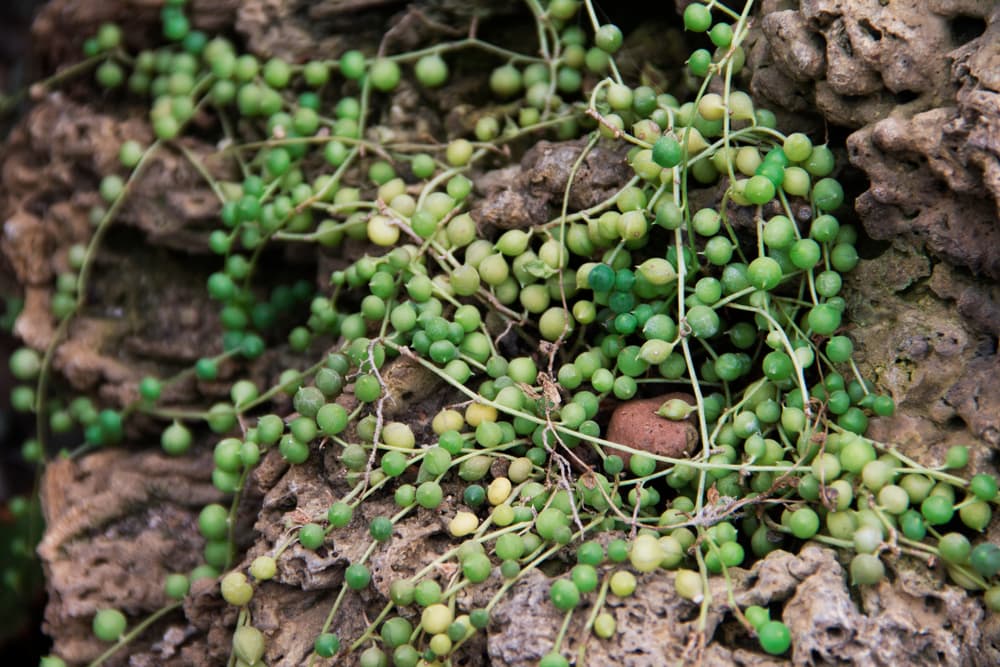
String of pearls only hangs downward when it’s kept in a pot high above the ground, and gravity can get involved.
In a healthy plant, the vines can trail to over 80cm in length, which is truly impressive.
Although it may not look like it, string of pearls is a succulent.
The little beads store water for drier times: a survival mechanism arising from the plant’s hot African origins.

Like other succulents, string of pearls is fleshy, thick-skinned, and attractive.
The plant is a perennial vine and, although it looks nothing like it, is part of the daisy family.
The scientific name is Senecio rowleyanus but, as usual, there’s a common name that rolls off the tongue much better – you’ll most likely see the plant called ‘String of Pearls’, but some people prefer ‘String of Beads‘.
(At least there’s agreement that the stringy appearance is the most striking aspect of the plant!)
Growing Indoors
Be warned: this plant can be quite challenging.
For novice gardeners, make sure you’re aware of the work involved before committing.

As a succulent, it’s really important not to water your string of pearls too often.
These plants have evolved to make do with minimal water, so saturating them too often will do more harm than good.
The best measure of when to water is when the soil feels completely dry.
String of pearls doesn’t need a large pot or container as it has a small root system.
While most plants need space to breathe, too much space can work against string of pearls by making it harder for the soil to dry properly.
Hardiness
As a plant hailing from arid regions of Africa, string of pearls is relatively resilient.

However, if you’re reading this, you’ll likely be growing yours in a region with a completely different climate.
Unfortunately, this often results in UK gardeners struggling to keep their string of pearls healthy.
It’s a finickity plant, and there are a good few indications that yours may not be thriving. Here’s what to look for:
- Shrivelling pearls
- Stems dying off
- Thin stems or pearls
The next sections give guidance on how to best care for your string of pearls.
Follow these tips, and you should have a healthy and happy plant.
Moving Outdoors
It’s not hard to see why a plant with African heritage won’t thrive in British winter.
Our average temperatures often dip far below the string of pearls’ ideal, and in winter they drop even further, falling below the lowest temperatures the plant can handle, around 0°C.

So, keeping your plant indoors for most of the year is the best bet.
In the summer months, though, you have the option to treat the plant to a short spell in the sun.
It’s not compulsory, but if you choose to do this, here’s how to do it:
- Put your string of pearls somewhere bright, but not in direct sunlight. Full sun exposure can burn the pearls.
- Try to find a spot where the plant gets sun in the morning or evening, but not during the heat of the day.
- Be vigilant with watering: don’t water too often, but don’t let the plant stay completely dry for too long.
As you can see, some care tips are tricky because it depends on the exact conditions where you’re growing.
If your string of pearls is likely to get rained on quite a lot, consider covering it or moving it indoors briefly to protect it.
“I have found that shelves adjacent to windows seem to provide enough light whilst avoiding scorching,” shares Horticultural Consultant Colin Skelly.
“They also provide the perfect perch from which S. rowleyanus can trail.”
Soil Requirements
This plant likes to dry out completely between waterings, so you need to choose a soil which is conducive to this outcome.
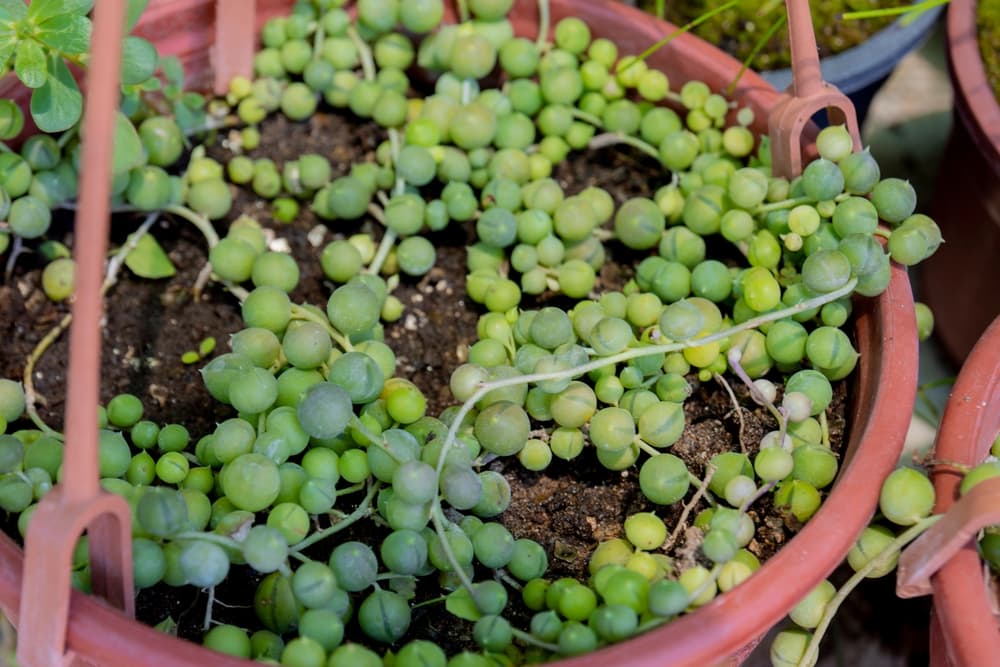
Something with large particles to allow good drainage, so keep an eye out for soil with sand, silt, or clay.
Other gardeners also recommend adding pumice or other ingredients to aerate the soil more.
Whatever soil you use, take care not to water an indoor string of pearls until it’s pretty much completely dried out.
Sunlight & Aspect
You want to choose a place for your Senecio that’s not too close to windows that have the sun shining through for large chunks of the day.
North- or east-facing windows are the best bet for your string of pearls, as they’ll give the plant light without risking burning or sun damage.
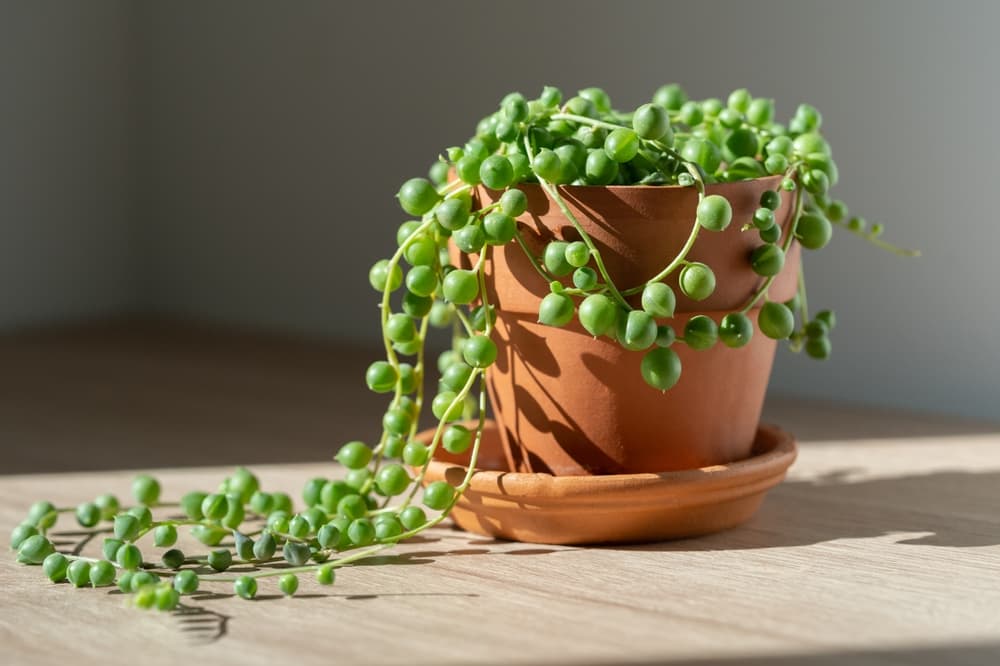
In the winter, when daylight hours are shorter, and the sun is less intense, you can move your string of pearls closer to a south- or west-facing window.
This will ensure it receives enough sunlight, and the reduced intensity means the risk of burn is lowered. Water less in the colder months, too.
Keep an eye on the condition of the plant in all seasons and rejig the location if it’s not thriving.
Ongoing Care
As we’ve said, this plant can be finickity.
This section contains a couple more care tips for your plant, designed to keep it in the best possible shape.
Misting
To keep your string of pearls in the best health, resist the urge to mist it.
While some houseplants benefit from misting, this one has evolved to survive in dry and arid environments.
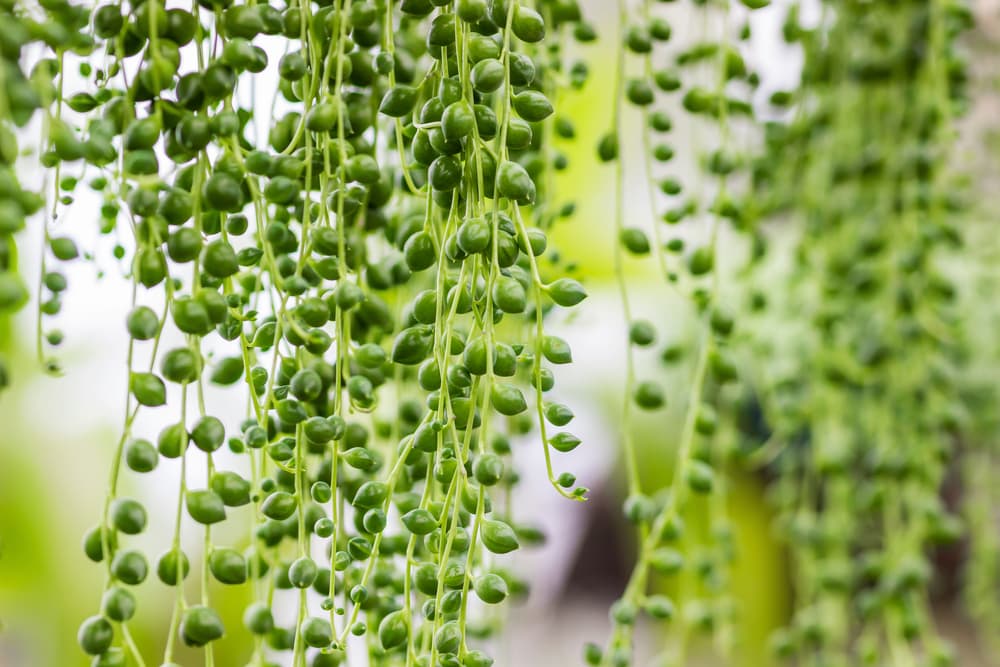
Too much moisture can actually be counterproductive, leading to damage and rot.
Pruning
You can prune withering stems to improve the overall health of the plant.
Prune back to a healthy section or, if the whole stem is dying, remove it completely.
Common Problems
This plant is susceptible to fewer pests than some other houseplants, which is a relief.
Here are the main ones you need to look out for:
Mealybugs
These sap-feeding insects love nothing more than slurping the sap right out of a plant’s leaves.
Over time this innocent feeding can cause untold damage to a plant, so it’s essential to be vigilant and deal with any infestations promptly.
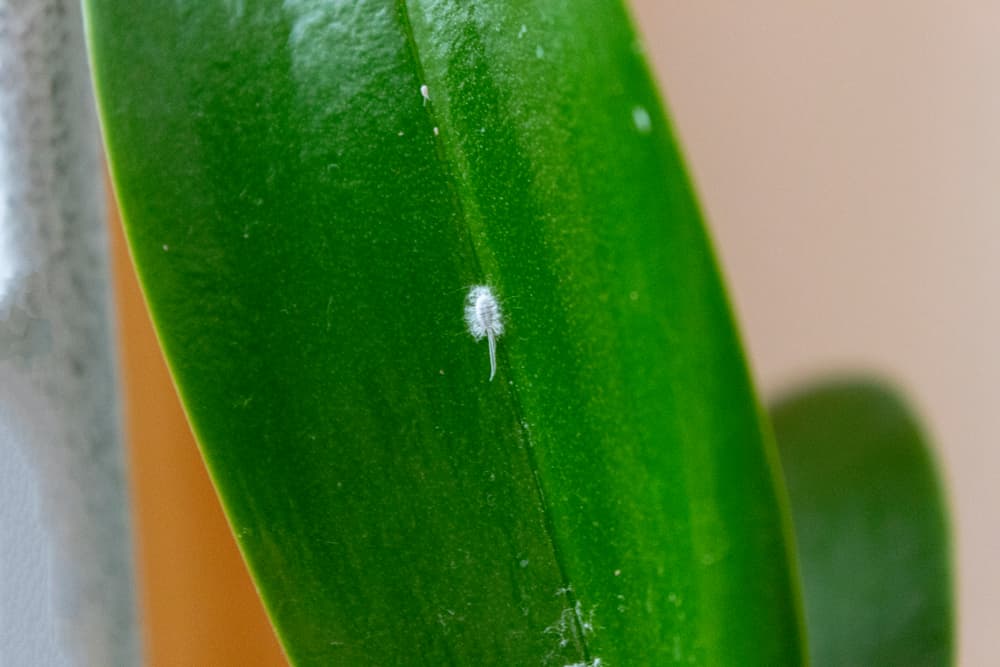
You’re looking for fluffy white wax or black sooty mould, as well as visible signs of an unhealthy plant like wilting and dying.
You can prune infected sections to see if this controls the mealybugs, but if not you may need to turn to stronger tactics.
Ladybirds will eat mealybugs, and various pesticides are available if you’d rather not introduce swarms of ladybirds into your home.
Aphids
Aphids also suck sap, and we have more than 500 species here in the UK. Yikes!2Aphids | What is an Aphid & What do they Look Like. (n.d.). The RSPB. Retrieved March 23, 2023, from https://www.rspb.org.uk/birds-and-wildlife/wildlife-guides/other-garden-wildlife/insects-and-other-invertebrates/beetles-and-bugs/aphid/
Aphids are visible with the naked eye, and they also leave behind a black sooty mould.
As with mealybugs, a bad infestation will make itself apparent through visible plant damage, so it’s a case of remaining vigilant.

You can squash aphids with your fingers if you find them, but if you’re looking for a more sustainable (and less icky) solution, introducing predators or using pesticides are your best bets.
Enough ‘Pearl Clutching’
There you go – everything you need to know to get a string of pearls established in your home.
This plant can put up more of a challenge than other houseplants, so if you’re a casual gardener, think carefully about whether it’s the right choice.
If you do decide to go for a string of pearls, though, we’re sure you’ll love it.
The plant is a real head-turner and brings a unique aesthetic character to any room.
Whether by itself or artfully arranged amongst your other houseplants, the string of pearls will quickly become a highlight.
References
- 1Senecio rowleyanus. (n.d.). Missouri Botanical Garden. Retrieved March 23, 2023, from https://www.missouribotanicalgarden.org/PlantFinder/PlantFinderDetails.aspx?taxonid=277546
- 2Aphids | What is an Aphid & What do they Look Like. (n.d.). The RSPB. Retrieved March 23, 2023, from https://www.rspb.org.uk/birds-and-wildlife/wildlife-guides/other-garden-wildlife/insects-and-other-invertebrates/beetles-and-bugs/aphid/

